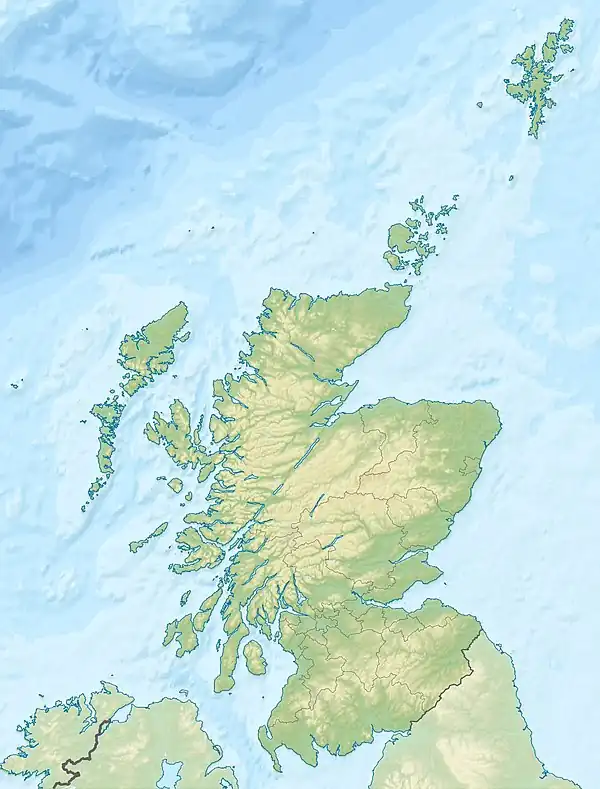Seafield Tower
Seafield Tower is a ruined castle on the North Sea coast of Fife in Scotland (grid reference NT279884). The monument is also referred to as a 'Medieval Tower House'.[1]
| Seafield Tower | |
|---|---|
| Fife, Scotland | |
 | |
 Seafield Tower | |
| Coordinates | 56.08295°N 3.16011°W |
| Type | Tower-house and courtyard |
| Site information | |
| Condition | ruined |
| Site history | |
| Built | c. 1542 |
| Built by | John Moultray |
| In use | until 1733 |
| Materials | Sandstone |
The tower is located on the route of the Fife Coastal Path.
History
Built in the 16th century (c. 1542),[2] Seafield Tower lies between Kinghorn and Kirkcaldy in Fife, Scotland. The lands of Seafield and Markinch were granted to Robert Multrare by James II of Scotland in 1443.[3] The lands and the tower remained in the ownership of the Multray family[4] (or Moultrie as the family name became) until 1631 when the lands were sold to James Law, the Archbishop of Glasgow.[5] With Law's death in 1632, the tower passed through various owners. The Methven family were the last known owners of the tower. Its last owner was Methven of Raith who abandoned it in 1733, leaving it to it fall into disrepair and, eventually, ruin.[6]
The completed tower was believed to be five stories high with walls 5 feet (1.5 m) thick and maximum internal dimensions of 20 feet 2 inches (6.1 m) by 14 feet 4 inches (4.4 m).[7] It was constructed in an 'L' shape configuration using local red sandstone. The Tower would have had a vaulted storage area on the ground floor and a Great Hall on the first floor. The upper levels would have been the lord's accommodation. A plan from 1774 shows ancillary buildings - including a bakery, brewery and stables - which were located in an enclosure to the west of the Tower.[8] These buildings would normally have been protected by a barmkin (curtain wall) but, unfortunately, any evidence of this has been lost due to coastal erosion.[9]
As it stands today, the ruin is merely a shell in derelict condition.[10] Following a storm in January 2013, a significant part of the northwest corner of the tower collapsed.[11]
Scheduled Monument
Between 1973 and 2015 the remains of the tower were designated a Category B listed building by Historic Scotland.[12] The tower was removed from Category B in 2015 as, since 2003, the tower and its surrounding area (which has been scheduled since 1937) have been designated as one combined scheduled monument.[13][14]
Images
References
- "Archaeology Notes | Canmore". canmore.org.uk. Retrieved 21 September 2018.
- "Seafield Tower". The Royal Commission on the Ancient and Historical Monuments of Scotland. 1933. Retrieved 4 May 2010.
- South Carolina Historical and Genealogical Magazine p. 230.
- Grant's Old and New Edinburgh vol.2 p.363
- South Carolina Historical and Genealogical Magazine p. 239.
- "Seafield Tower | Perthshire, Kinross, Angus and Fife | Castles, Forts and Battles". www.castlesfortsbattles.co.uk. Retrieved 21 September 2018.
- South Carolina Historical and Genealogical Magazine p. 243.
- "Seafield Tower | Canmore". canmore.org.uk. Retrieved 21 September 2018.
- "Seafield Tower | Perthshire, Kinross, Angus and Fife | Castles, Forts and Battles". www.castlesfortsbattles.co.uk. Retrieved 21 September 2018.
- "Seafield Tower | Canmore". canmore.org.uk. Retrieved 21 September 2018.
- "Seafield Tower | Perthshire, Kinross, Angus and Fife | Castles, Forts and Battles". www.castlesfortsbattles.co.uk. Retrieved 21 September 2018.
- Historic Environment Scotland. "Seafield Tower (LB9710)". Retrieved 25 March 2019.
- "Seafield Tower". Historic Scotland. Retrieved 24 February 2017.
- Historic Environment Scotland. "Seafield Tower (SM873)". Retrieved 25 March 2019.
Further reading
- "The Moutries". The South Carolina Historical and Genealogical Magazine. Charleston, SC: South Carolina Historical Society. 5 (2): 228–260. 1904. JSTOR 27575081.
- Coventry, M. Castles of the Clans: the strongholds and seats of 750 Scottish families and clans. Edinburgh: RCAHMS. 2008. RCAHMS Shelf Number: F.5.21.COV. Page(s): 420,437.


